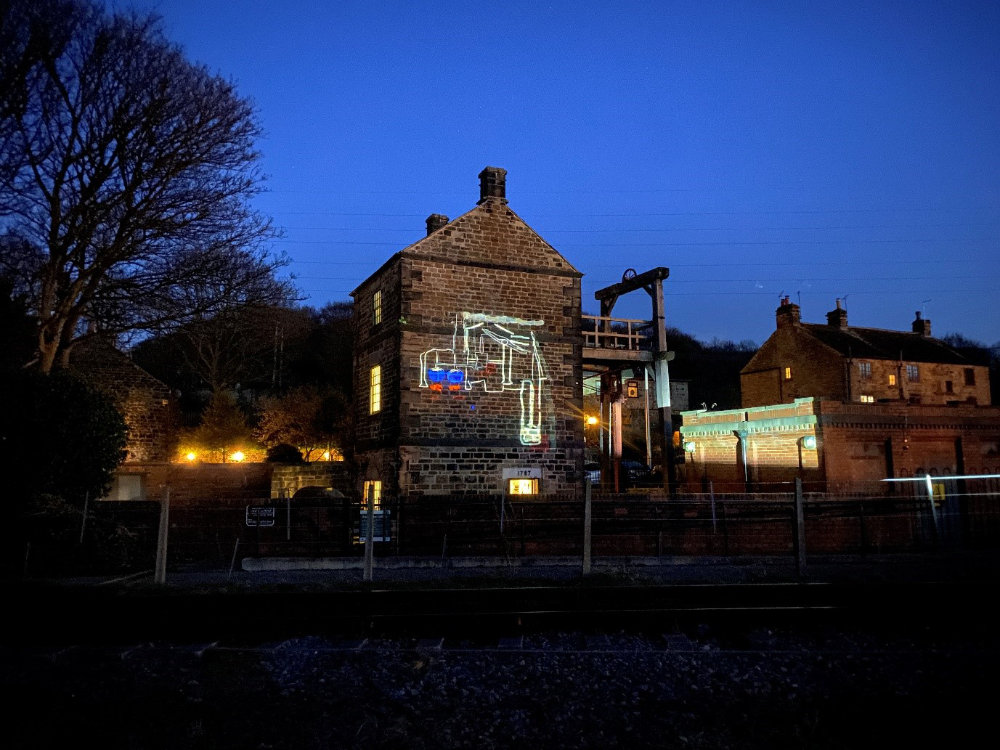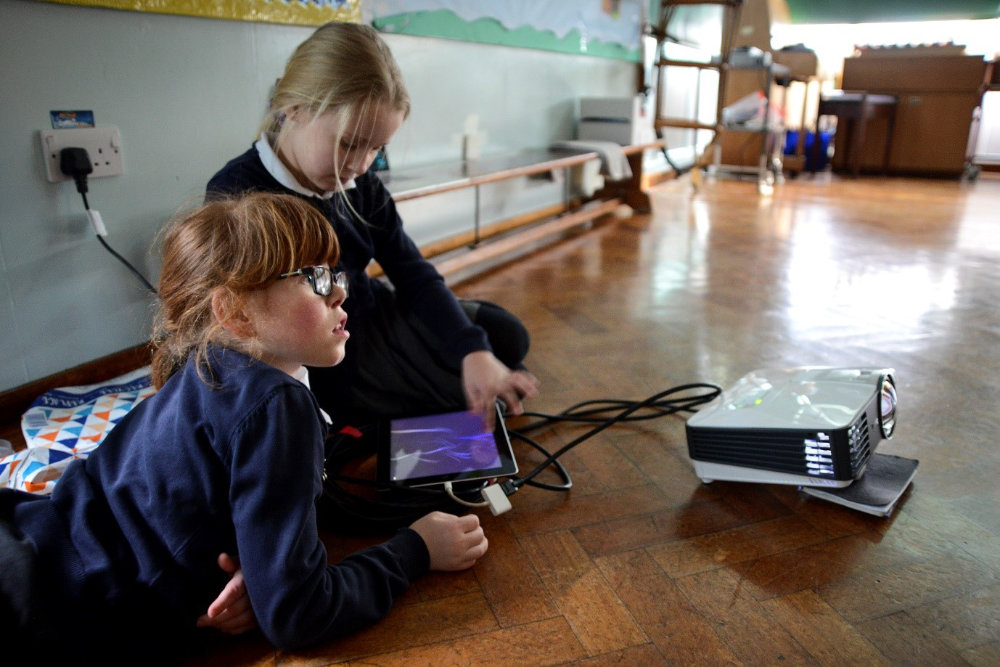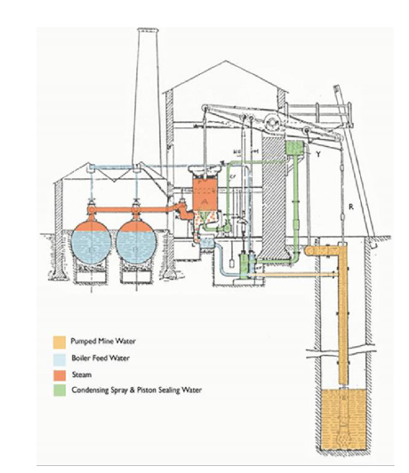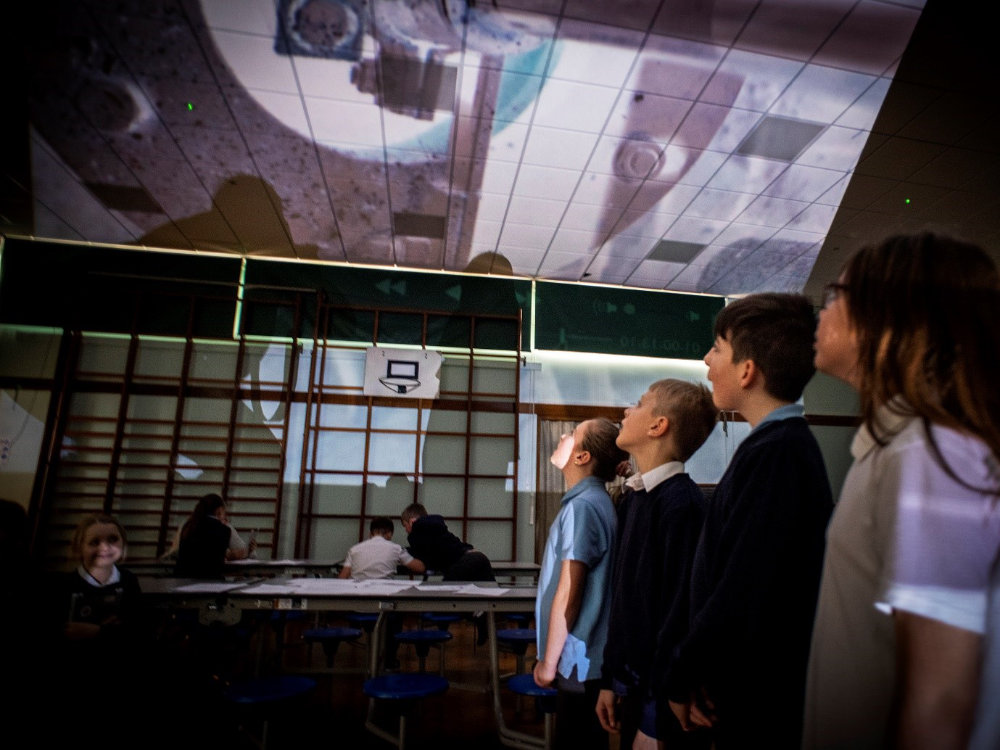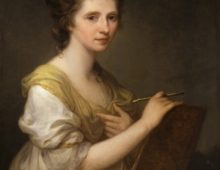How to create an animated projection map
This activity is suitable for Ages 9+
Projection mapping uses everyday video projectors, but instead of projecting onto a flat screen (e.g. to display a PowerPoint), images and animations can be mapped onto any surface, bringing 3D objects to life.
This activity was developed by the Learning team at Barnsley Museums. They worked with Year 5 students from Jump Primary School to animate and project the internal workings of the Newcomen Beam Engine onto the external wall of its building at Elsecar Heritage Centre.
See how they did this and the wonderful projections they created here. All students achieved Arts Award Discover as a result of the work they carried out during the project.
Use this step-by-step guide to create projection maps in the Classroom. To replicate Jump Primary’s project, please see below for detailed notes on the Newcomen Engine.
1. Inspiration
The Age of Revolution saw the beginnings of mechanisation – the use of machines to do work previously done by people or animals. This, in turn, led to the Industrial revolution. Before the introduction of gas and electricity, most of these machines were fuelled by coal and powered by steam.
Students can begin by looking at some of the machines from the Age of Revolution. They could also do this through a visit to a local Museum and/or by exploring some of the machines from our Revolutionary Collection e.g:
- Newcomen Engine (the first steam powered machine)
- Boulton & Watt steam engine
- Locomotion I (the first passenger train locomotive)
- Koenig & Bauer’s steam powered printing press
- Montgolfier hot air balloon
- The Telegraph
- Difference Engine No.1 (the first computer)
- Charlotte Dundas steam boat
Can they find out how they work?
What impact might they have had on people’s lives?
Do we have machines that are anything like these today?
(A guide to introducing the Age of Revolution can be found here.)
2. Resources
- iPads – ideally one between two
- Tagtool pro – an App for painting with light – create animated words or drawings
- Dynamapper – an App for creating stunning visual shows by connecting your iPad to a projector
- An ordinary projector
Optional resources:
Thicket classic (optional) – an App for practising simple projection mapping
iMovie
Adobe Spark Video
Adobe Spark Post
All of the above are apps for creating videos/news reports to document the project
If all of your iPads are connected to the same itunes account, you will be able to just buy the apps once and download them to all devices.
3. Using Tagtool
Tagtool is a great way to create colourful drawings and words, and to animate them.
The students from Jump Primary school used it to make simple, animated drawings of the Newcomen Engine, and to create animated words to describe it.
The best way to understand Tagtool is to experiment with the App. We made a simple tutorial which can be viewed here. There are a series of other useful tutorials here.
Give students a brief overview of Tagtool. Give them time to work out how to use the software and experiment – they will pick a lot up from just doing this. Ask the students to create their names and experiment with animating them. They can then share their animations with the rest of the group.
If all of your iPads are all running the latest software and are connected to the same wi-fi you can use one iPad as a server to connect all the other iPads. This ’master’ iPad needs to be connected to a school projector.
Connect the iPads to the main Tagtool master iPad and project the students work. The great thing about this approach is that all the students’ iPads will project at the same time allowing the students to create together in real time. Students will see their projections side by side and be able to work on their individual one at the same time as their peers.
If you are unable to connect to wi-fi you can connect each student’s work individually to the projector to share their work full size.
By sharing their work, students can provide each other with feedback and be inspired by each other’s ideas.
4. Creating your animation with Tagtool
Decide together on a machine to focus on. It could be something from our Revolutionary collection (see examples above), something you saw on a museum visit, something in your school – like a clockwork toy or the photocopier, or something from the students’ lives like a car, bus, cooker or games console.
Decide where you are going to project your animations – what will you bring to life?
- You could project onto the object itself if it’s large enough
- Students could cut the outline shape of their chosen machine (e.g. a clockwork animal) from a large piece of paper and project onto it
- Students could create a large, simple 3D model of their machine from cardboard boxes (e.g. a bus or the building housing the Newcomen Engine) – to project onto.
Talk together about how the machine (basically) works. Students then choose four-six elements to sketch , creating a ‘How does it work?’ story board. E.g. for a clockwork car, they could create four sketches:
-
- Turning the key to wind the metal strip inside into a tight coil
- The coil turning a set of cogs
- The cogs turning the back wheels of the car
- The wheels making the car move forward
Take a photo or use an existing image or diagram of your chosen ‘machine’ using the iPad’s camera. Then import the photo into TagTool.
Students use the image as a template to draw around.
The students from Jump Primary School drew around this diagram of the internal workings of the Newcomen Engine:
Each element the students want to animate then needs to be drawn on a separate layer.
Once they have drawn all their layers – using their ‘How does it work?’ sketches for reference – they then animate the different element in each layer.
Once all layers have been animated, the original picture/diagram in the background can be deleted and the layers combined to show an animation of the inner workings of the machine.
Project each pair’s animated work onto the wall of the learning space using the projector.
5. Creating your projection map with Dynamapper
Dynamapper allows students to create visual shows by connecting their iPads to a projector. We made a simple tutorial here. Find out even more here.
Allow pupils to experiment with the app in pairs. Get them to create at least four or five different images – either using default pictures from the app or photographs/videos they have taken themselves.
Set up your learning space with different objects spread across a blank wall e.g. gym mats, boxes, chairs etc. Pairs then take it in turns to connect their iPad to the projector and manipulate the different images they have made to project them onto these different objects, making sure the shape and size of the image correctly maps onto the shape of the objects. This is done by stretching or contracting the shape on the iPad until it matches the shape of the object you are projecting onto.
The drawings and animations students made using Tagtool can then be imported into Dynamapper and projected onto their chosen space or object. Additional optional activities:
Thicket
Thicket is an audio visual App that allows anyone to create beautiful sounds and pictures from simple finger touches. This is a good way for students to experiment with projection mapping before using their own designs with Dynamapper. Find out more here.
Films
Using any of the video making and editing apps suggested above, students can film their progress throughout the project, creating a ‘how we made it’ video. They could should give short interviews about what they are doing and how and why.
Footage could be edited together with the projections to create one longer film showcasing the whole project. This could be projected onto the wall of your learning space, or onto an external building wall.
View the film made with students from Jump Primary here.
6. The Newcomen Engine
Barnsley Museums have provided additional information and resources below for teachers planning to focus on the Newcomen Engine.
Schools local to Elsecar can visit Elsecar Heritage centre and the Engine itself to find out more.
Others can use the Newcomen Engine information in our Revolutionary Collection and the resources below.
1795
What happened during this year?
The new shafts at Elsecar New Colliery were finished, and the engine began its working life, pumping water from Elsecar’s first deep coal mine.
When the shafts were finished, the Earl Fitzwilliam paid for a celebration feast.
Characters
The Fourth Earl Fitzwilliam – paid for the coal mine to be sunk and the Engine to be built. He called it his ‘Great Engine’. He lived in nearby Wentworth Woodhouse.
Benjamin Hall – the Earl’s Steward (who was in charge of making sure all the building work was done properly)
John Bargh – an engineer from Chesterfield who designed and built the engine
Martha Hague – helped her brother to dig the shafts. She worked the horse gin, which pulled the soil and rubble up to the surface.
John Hague (Martha’s brother) and Richard Watson – in charge of the team who dug the shafts
Other things to consider/background information
Before the New Colliery was built the area where the engine now stands was part of Simon Wood and would have been covered in trees.
On the day that work started on the shafts and the first ‘sod’ was dug, the Earl paid for a bottle of sod ale to celebrate.
Very soon after the new coal mine was finished, new houses were built for families coming in to the area to work and Elsecar village was started. The houses were considered to be very spacious and modern for the time, with their own gardens and allotments. How do you think the new residents would have felt moving into the Earl’s new village?
1815
What happened during this year?
Tar distillery explosion on Distillery Side
Characters
Mr Parker –came down from the North of England, at the request of the Earl Fitzwilliam, to start a new coal tar distillery. He experimented in a barn at Skiers Hall before carrying the stills down to the Elsecar New Colliery by horse and cart.
Mr Parker began to charge the new stills on September 19th 1814, watched by the Lord Milton and the Earl Fitzwilliam himself.
The process was very dangerous, and during the first six months there were a number of explosions at the distillery – the first being on January 1st 1815, when the condensor blew up.
Other things to consider/background information
The Earl Fitzwiliam and Lord Milton came down to see the first day of production. Imagine what it was like living in the houses nearby. Do you think they would have come down for a look too?
The distillery was very close to the cottages on Distillery Side. How do you think the people living here felt when they heard the explosion? How far away for you think it could be heard?
The distillery made coal tar, varnishes and lamp black, which were shipped out by canal. They were very popular.
The distillery closed in January 1818, but the road it was on (next to the engine is still known as Distillery Side).
1836
What happened during this year?
A new cast-iron beam was made for the engine (the same beam that is in the engine house now). The old wooden beam had rotted and needed to be replaced.
At the time Elsecar had two ironworks – one where the heritage railway is now, and one up the hill at Millton. The furnaces ran through the night and you could see them for miles around.
The new beam was cast at the Milton Ironworks and brought down to Elsecar by horse and cart.
The new beam had to be lifted up to the top of the engine house by hand, using a winch – it weighs over 4 tonnes.
Characters
We don’t know the names of the people involved, but characters you could think about might include:
The people who made the new beam. How do you think they would have felt knowing that their work was going to be part of the Earl’s Great Engine?
The people who brought the beam down the hill on a horse and cart – imagine how heavy it would have been, and how many horses you would have needed to pull it.
The people who lifted the beam into the engine house – how hard do you think it would have been to lift?
Other things to consider/background information
Bringing the new beam down into Elsecar and lifting it into the engine house would have been a real spectacle – imagine living in one of the houses nearby and watching it all happen.
Do think anything got damaged on the way?
1850
What happened during this year?
The new Elsecar workshops (now the Elsecar Heritage Centre) opened. They were built by the Earl Fitzwilliam to serve his coal mines, ironworks, and his estate. The new workshops were up to date and new, with room for blacksmiths, leather workers, carpenters and more.
As part of the new development, Wath Road was straightened, and new pubs, shops and houses were built along Hill Street, making the village look and feel very different.
Characters
The Earl Fitzwilliam – the workshops belonged to him, and he was very proud of how modern and up to date they were. He brought many rich and famous people to see them.
Benjamin Biram – the Earl’s Steward. He was in charge of the new workshops. His dad, Joshua, had been the Earl’s steward before him.
People who worked at the new workshops – they might already have lived in Elsecar, or might have come to Elsecar specially to work for the Earl.
Other things to consider/background information
Before the workshops were built, Elsecar was much smaller, although it had a busy ironworks, coal mine and canal. The area where the workshops were built was mostly fields. Imagine how different it would have been when they opened in 1850 – with all the new activity, noise and smells from the workshops and the huge chimney towering overhead.
In 1850 the Elsecar workshops would have been very modern and impressive. Lots of visitors came to see them, including royalty. Do you think there was a celebration when they opened?
When Wath Road was straightened, a lot of the existing workers’ houses (e.g. Station Row and Reform Row) lost their allotments because the land was needed for the new road. How do you think the people in the houses would have felt about that?
1928
What happened during this year?
The new electric pumps that had been installed in 1923 to replace the Newcomen engine were damaged in a flood. Until they could be mended the old steam engine was brought back into use.
When the boilers were lit, the smoke made the neighbours’ washing all sooty.
Characters
The people working on the pumps/engine
People living in the houses nearby
Other things to consider/background information
Imagine being one of the people in the houses nearby when the old engine was brought back into use. How do you think they would have felt seeing it running again?
Remember, they would have seen the engine nodding up and down all their lives, but the new electric pumps were clean and the old engine ran on coal, which was smokey and smelly.
How difficult do you think it might have been to get the old engine working again?
1937
What happened during this year?
The old boiler house and chimney were knocked down
Characters
The people working on the demolition
People living in the houses nearby
Other things to consider/background information
Imagine being one of the people in the houses nearby when the chimney was knocked down. Do you think it made a noise? How do you think they felt?
Imagine being one of the people carrying out the work. We know that they were very careful about how they did it, and tried to leave as much of the floor and foundation walls in place as possible. Why do you think they might have done that?
Newcomen Engine Timeline
1712 – Thomas Newcomen builds his first atmospheric mine pumping engine
1775 – James Watt builds his first ‘improved’ atmospheric engines (with separate condenser)
1794/5 – Newcomen-type Engine built at Elsecar by the Earl Fitzwilliam of Wentworth House 1795 – Elsecar New Colliery Opens
1795 – First furnace established at Elsecar Ironworks by Darwin and Co. Ltd. of Sheffield 1795/6 – First workers cottages built in Elsecar, at Old Row and Distillery Side
1798 – Elsecar branch of the Dearne and Dove Canal Opens
1800 – New workers cottages built at New Row (now Station Row) to designs by architect John Carr
1801 – First blast furnace established at the Milton Ironworks by the Walker Brothers of Rotherham
1802 – Original cylinder replaced (to give greater pumping capacity)
1803 – 1815 Napoleonic Wars
1815 – Tar Distillery explosion on Distillery Side
1836 – Wooden beam replaced by large cast-iron beam, made at the Milton Ironworks. Other innovations, including parallel link motion, added.
1837 – New waggonway network completed between Elsecar canal basin and the Milton Ironworks
1848 – Elsecar Low Colliery (Hemingfield Colliery) opens
1850 – Elsecar New Yard workshops built
1853 – Simonwood Colliery opens and Elsecar New Colliery (then called Elsecar Mid Colliery) closes.
Newcomen Engine retained as a pumping station for the wider valley.
1853-1856 Crimean War
1880s – Elsecar and Milton Ironworks close
1905/8 – Elsecar Main Colliery Opens
1914-1918 First World War
1918 – South Yorkshire Pumping Association formed
1920 – Hemingfield Colliery, Elsecar and Rawmarsh Pumping Stations sold to the South Yorkshire Pumping Association by the Earl Fitzwilliam
1923 – New electric pumps installed replacing the Newcomen Engine. Newcomen Engine retained as emergency back-up pump
1928 – Electric pumps damaged in flood. Newcomen Engine brought back into use for a short period
1937 – Newcomen Engine boiler house and chimney demolished
1939-1945 Second World War
1947 – Nationalisation of the Coal Mining Industry. Pumping stations taken into control of the National Coal Board (NCB)
1950s – Newcomen Engine falls into complete disrepair
1983 – Elsecar Main Colliery closes
1984/5 – Miners’ Strike (first strike action at Cortonwood Colliery)
1987 – Elsecar Workshops (formerly Elsecar New Yard) close
1994 – Elsecar Heritage Centre opened by HRH Elizabeth II, in the restored buildings of the Elsecar Workshops. Denationalisation of the Coal Industry – pumping stations closed.
2012/15 – Newcomen Engine restored by Barnsley Museums (with funding from the NHLF and Historic England)
2016 – Newcomen Engine re-opened by HRH the Earl of Wessex
2019 – Former boiler house uncovered by community dig as part of the Elsecar Heritage Action Zone and Wentworth


